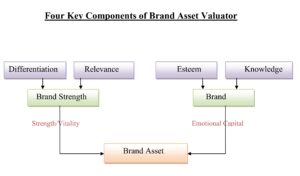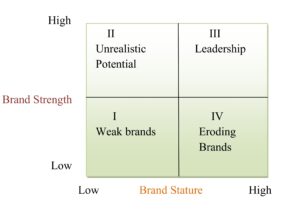Brand Asset Valuation
Brand Asset Valuator measures the value of a brand where it is created: in people’s hearts and minds. It provides a diagnostic framework to help the company’s build, leverage, and maintain their brands.
Advertising agency Young and Rubicam (Y&R) developed a model of brand equity called Brand Asset Valuator (BAV). Based on research with almost 200,000 consumers in 40 countries, BAV provides comparative measures of the brand equity of thousands of brands across hundreds of different categories. There are four key components—or pillars— of brand equity, according to BAV.
- Differentiation measures the degree to which a brand is seen as different from others. How much your brand stands out from the rest. Has your brand attracted consumers’ attention more than your competitors? Measure this by asking questions about how often consumers have come across your brand, if they recognize your brand, and how different it is from your competitors.
- Relevance measures the breadth of a brand’s appeal. How appropriate your brand is for consumers. Would consumers want to purchase your product or service? Is your product relevant to consumers in regards to price, convenience, and fulfilling their needs? You can determine your brand’s relevance by asking consumers how likely they would be to purchase your product or service, regardless of whether or not they have purchased your product or service in the past.
- Esteem measures how well the brand is regarded and respected. How well regarded your brand is. Ask consumers to assess your company’s reputation and brand personality. How different, innovative, dynamic, reliable, helpful, and highly regarded is your brand?
- Knowledge measures how familiar and intimate consumers are with the brand. How well consumers know your brand. What are your target consumers’ assumptions about your brand, and are they positive or negative? Ask consumers to tell you what they know—or what they think they know—about your company and its products or services.
Brand Strength
Brand Strength = Differentiation X Relevance
Brand strength represents differentiation multiplied by relevance. The logic is that a brand must have both characteristics in order to be strong. Further, it is not easy to have high marks in both; few brands high on one dimension are also high on the other. Note how few of the top ten brands on differentiation and relevance made the top ten on brand strength. Growing brands and strong, established brands such as Hallmark and Disney tend to be high on brand strength.
Brand Staure
Brand Stature = Esteem X Knowledge
Esteem and knowledge complete the hierarchy and combine to form the brand stature construct. As Brand Strength was found in the relationship between Relevance and Differentiation, Brand Stature is discovered in the combination of Esteem and Knowledge. Brand Stature indicates brand status and scope – the consumers’ response to a brand. As such, it reflects current brand performance and is a strong strategic indicator. For example, Esteem rises before Knowledge for a growing brand. If rankings show the opposite relationship, a problem may have been identified The combination of Esteem and Knowledge form Brand Stature , a more traditional measure that Brand Asset Valuator has determined to be a lagging indicator of brand health.
Comparing a brand’s esteem with its knowledge often provides some important insights. For instance some brands rank higher in esteem than in knowledge. This means that relatively few people understand what the brand stands for, but those who do hold it in high regard. A brand in this situation is likely to have some unrealized potential-which it may or may not be poised to take advantage of-if it can find a way to expand knowledge.
According to the BAV model, it’s important to measure how differentiation, relevance, esteem, and knowledge relate to one another so you can determine your brand strength and stature. Here are the most important dynamics to note:
- Differentiation is higher than relevance.When your brand is different, consumers are curious as to why and want to learn more. This can attract customers, get them to explore the brand, and find out if it is relevant to them.
- Relevance is higher than differentiation.When your brand is more relevant to consumers than it is differentiated from other brands, your brand is no longer interesting or pulling in consumers. You are now competing on relevance alone, which means that consumers will only purchase your product or service based on price or convenience.
- Esteem is higher than knowledge.When consumers hold your brand in high esteem, they respect and desire your brand because it is so well regarded. Consumers want to purchase your product or service to find out why it garners consumer loyalty.
- Knowledge is higher than esteem.When consumers claim to already know all about your company, this can lead to problems, especially if they believe they know negative things about your brand. Consumers who think they don’t need to learn anything else about your brand have already judged it—and this means they may be looking to learn more about your competition and less about you.
The Power Grid
Y&R plots brands on a ” Power Grid ” reflecting each brand’s Strength and Stature.The Power Grid sets the strategic process by identifying the strength or weakness of a brand. On the vertical axis we plot the brand strength – its relevance and differentiation, while on the horizontal axis, the brand stature -esteem and knowledge.
Brand Strength
Brands must possess both differentiation and relevance to be strong(Disney,Britannia,Hallmark)
Brand Stature
This strategic indicator is a combination of Esteem and Knowledge and reflects current brand performance(BPL,Pepsi).Esteem increases before knowledge for chocolates,soft drinks and other impulse-purchase products.
Further diagnostic information can be obtained from a stature-by strength diagnostic framework termed a power grid, as shown in the figure below:
The Power Grid sets the strategic process by identifying the strength or weakness of a brand. On the vertical axis we plot the brand strength – its relevance and differentiation, while on the horizontal axis, the brand stature -esteem and knowledge.
Quadrant I: Weak brands that could not leverage their strengths.
Quadrant II: Here the brand managers have not been able to realise the true potential of the brand. The strategy should be to build the stature of the brand.
Quadrant III: The challenge for the brand here would be to continue being a leader.
Quadrant IV: The last quadrant spells “Danger” for the brand, an indicator of eroding potential.
These brands have failed to maintain their Relevant Differentiation (their core strength). If unattended, their Stature will also begin to fall. Unless steps are taken to stimulate the differentiation and relevance, these brands will lose Esteem and could eventually fade from consumers’ consciousness.
The value of a brand depreciates if there is no continuous value addition. This is critical for the brand to be a source of competitive advantage. The task of a marketer is to go beyond measuring and leveraging the value of the brand and add perceptible value continuously.



